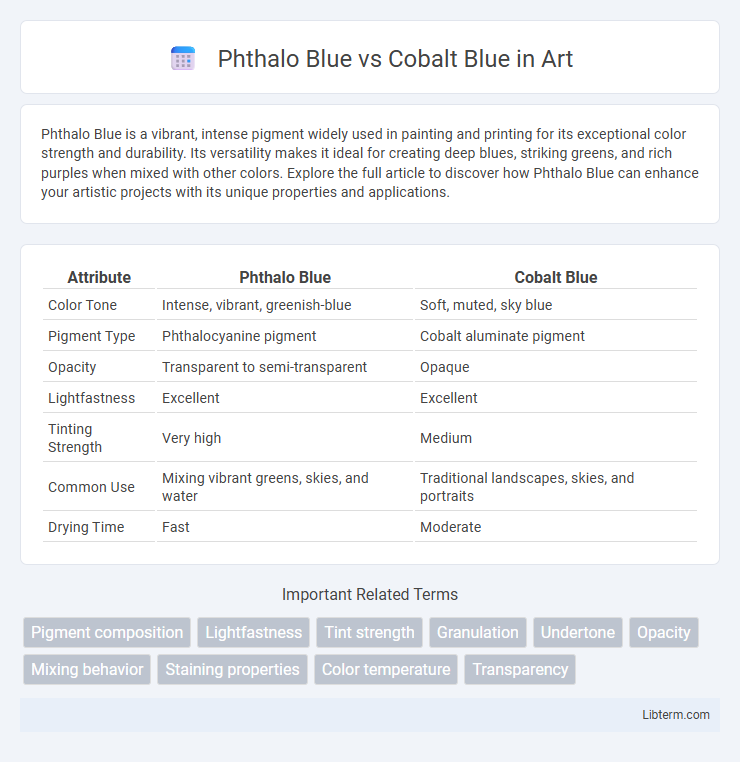Phthalo Blue is a vibrant, intense pigment widely used in painting and printing for its exceptional color strength and durability. Its versatility makes it ideal for creating deep blues, striking greens, and rich purples when mixed with other colors. Explore the full article to discover how Phthalo Blue can enhance your artistic projects with its unique properties and applications.
Table of Comparison
| Attribute | Phthalo Blue | Cobalt Blue |
|---|---|---|
| Color Tone | Intense, vibrant, greenish-blue | Soft, muted, sky blue |
| Pigment Type | Phthalocyanine pigment | Cobalt aluminate pigment |
| Opacity | Transparent to semi-transparent | Opaque |
| Lightfastness | Excellent | Excellent |
| Tinting Strength | Very high | Medium |
| Common Use | Mixing vibrant greens, skies, and water | Traditional landscapes, skies, and portraits |
| Drying Time | Fast | Moderate |
Introduction to Phthalo Blue and Cobalt Blue
Phthalo Blue is a vibrant synthetic pigment known for its intense tinting strength and transparency, frequently used in acrylic and oil painting to create vivid blues and greens. Cobalt Blue, derived from cobalt salts, offers a more muted and opaque hue with excellent lightfastness, making it a traditional favorite for artists requiring stable and durable blue tones. Both pigments serve distinct purposes in fine art, with Phthalo Blue prized for its brightness and mixing versatility, while Cobalt Blue is valued for its softness and permanence.
Chemical Composition and Origins
Phthalo Blue, or Copper Phthalocyanine, is a synthetic pigment characterized by its intense blue hue and superior tinting strength, originating from a copper complex of phthalocyanine molecules developed in the 1930s. Cobalt Blue, chemically known as Cobalt(II) aluminate, is an inorganic pigment formed by sintering cobalt oxide with aluminum oxide, first synthesized in the early 19th century as a stable and opaque blue pigment. The contrasting chemical compositions--organic metal complex for Phthalo Blue versus inorganic metal oxide for Cobalt Blue--result in distinct visual qualities and applications in art and industry.
Color Characteristics and Visual Differences
Phthalo Blue exhibits a vibrant, intense hue with high tinting strength and excellent transparency, making it ideal for glazing and mixing. Cobalt Blue offers a softer, more muted tone with moderate opacity and granulating properties, providing a natural, earthy feel. Visually, Phthalo Blue appears cooler and more electric, while Cobalt Blue presents a warmer, more subdued appearance.
Lightfastness and Permanence
Phthalo Blue exhibits superior lightfastness with a permanence rating of ASTM I, indicating excellent resistance to fading under prolonged exposure to light. In contrast, Cobalt Blue typically holds an ASTM II rating, making it moderately resistant to light but less permanent than Phthalo Blue. Artists seeking long-lasting vibrancy often prefer Phthalo Blue for its durability and stable pigmentation in artworks.
Mixing Properties and Versatility
Phthalo Blue offers intense tinting strength and exceptional mixing versatility, producing vibrant greens and deep shadows when combined with yellows and reds. Cobalt Blue delivers softer, more subtle blends, ideal for pastel mixtures and atmospheric effects due to its moderate opacity and lighter hue. Artists favor Phthalo Blue for bold, high-impact color mixes, while Cobalt Blue excels in nuanced, delicate transitions in paint applications.
Opacity and Transparency
Phthalo Blue is known for its intense opacity and strong tinting strength, making it ideal for vibrant, solid coverage in paintings. Cobalt Blue offers a more transparent quality with moderate opacity, allowing underlying layers to subtly show through and creating depth in glazes. Artists often choose Phthalo Blue for bold, opaque applications, while Cobalt Blue is preferred for delicate, translucent effects.
Historical and Artistic Significance
Phthalo Blue, first synthesized in 1935, revolutionized the art world with its vibrant, intense hue and superior tinting strength compared to the more muted, historically prized Cobalt Blue, discovered in the early 1800s. Artists favored Cobalt Blue for its stability and subtle, soft blue tones in traditional landscapes and portraits, while Phthalo Blue's synthetic origin offered unparalleled brilliance and versatility in modern and abstract artworks. The contrasting chemical compositions--Phthalocyanine pigment for Phthalo Blue and cobalt aluminate spinel for Cobalt Blue--underscore their distinct roles in artistic evolution and color technology.
Applications in Various Mediums
Phthalo Blue exhibits exceptional vibrancy and transparency, making it ideal for glazing techniques in oil and acrylic painting, while its intense staining properties are favored in watercolor applications. Cobalt Blue offers a softer, more muted tone with excellent opacity and durability, suited for fine art oil paintings and ceramic glazes where color stability at high temperatures is essential. Both pigments serve distinct roles: Phthalo Blue excels in mixing and layering effects across mediums, whereas Cobalt Blue is prized for traditional brushwork and permanence in mixed media projects.
Price and Availability
Phthalo Blue generally offers a more affordable price point than Cobalt Blue, making it a popular choice for budget-conscious artists. Phthalo Blue is widely available across most art supply retailers, both online and in physical stores, due to its synthetic production process. In contrast, Cobalt Blue tends to be more expensive and less readily available because it is made from natural cobalt minerals, driving up costs and limiting supply.
Choosing Between Phthalo Blue and Cobalt Blue
Phthalo Blue offers intense, vibrant color with high tinting strength and excellent coverage, making it ideal for bold applications and mixing bright greens. Cobalt Blue, known for its softer, more muted tone and lower tinting strength, works well for subtle shading and creating pastel hues. When choosing between Phthalo Blue and Cobalt Blue, consider the desired intensity and transparency in your artwork, as Phthalo Blue excels in vivid expression while Cobalt Blue provides delicate, nuanced color effects.
Phthalo Blue Infographic

 libterm.com
libterm.com